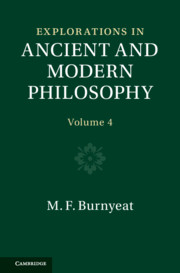Book contents
- Explorations in Ancient and Modern Philosophy
- Explorations in Ancient and Modern Philosophy
- Copyright page
- Contents
- Illustrations
- Preface
- Acknowledgements
- Abbreviations
- Introduction
- Part I Ontology and epistemology
- Part II Physics and optics
- Chapter 8 ΕΙΚΩΣ ΜΥΘΟΣ
- Chapter 9 Aristotle on the foundations of sublunary physics
- Chapter 10 Archytas and optics
- Chapter 11 ‘All the world’s a stage-painting’: scenery, optics, and Greek epistemology
- Bibliography
- Index locorum
Chapter 8 - ΕΙΚΩΣ ΜΥΘΟΣ
from Part II - Physics and optics
Published online by Cambridge University Press: 24 March 2022
- Explorations in Ancient and Modern Philosophy
- Explorations in Ancient and Modern Philosophy
- Copyright page
- Contents
- Illustrations
- Preface
- Acknowledgements
- Abbreviations
- Introduction
- Part I Ontology and epistemology
- Part II Physics and optics
- Chapter 8 ΕΙΚΩΣ ΜΥΘΟΣ
- Chapter 9 Aristotle on the foundations of sublunary physics
- Chapter 10 Archytas and optics
- Chapter 11 ‘All the world’s a stage-painting’: scenery, optics, and Greek epistemology
- Bibliography
- Index locorum
Summary
What did Plato mean when in Timaeus he characterised his account of the created world as an εἰκὼς μῦθος? The phrase is typically translated ‘a probable story’, ‘a likely tale’. Connotations that modern empiricist philosophy of science might attach to those expressions are misleading. Careful attention to the two terms Plato uses, and their resonances in previous Greek literature and thought, suggests instead the strikingly oxymoronic: ‘a rational/reasonable myth’. This is not, however, the reasonableness of deduction or of inference to the best explanation, but of the practical reasoning in which a supremely good designer would probably engage, assuming that he wanted to make his product as like himself as possible, but from materials with their own properties not of his making. Practical wisdom cannot aspire to the same standards of rigour as theoretical wisdom can. It can attempt only the most reasonable option given such constraints – as could any account of why that choice was made. Hence the importance of the Timaeus’ initial reminder of Socrates’ construction of a political order (witness the Republic), and its address to a company competent in politics as well as mathematics, interested no less in κόσμος as political order than in cosmology.
- Type
- Chapter
- Information
- Explorations in Ancient and Modern Philosophy , pp. 265 - 285Publisher: Cambridge University PressPrint publication year: 2022



